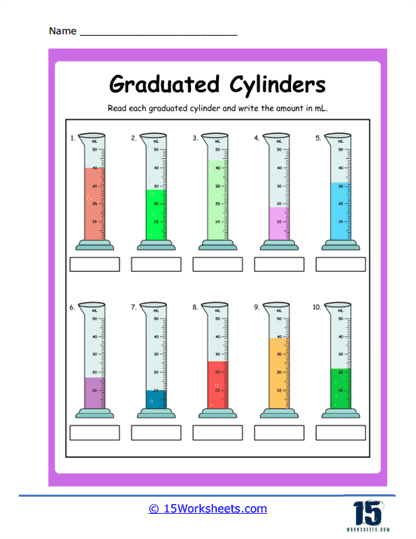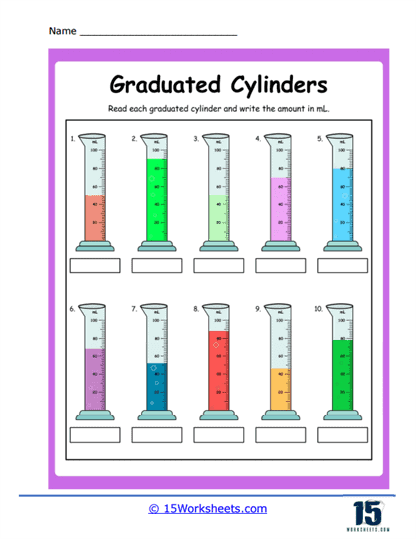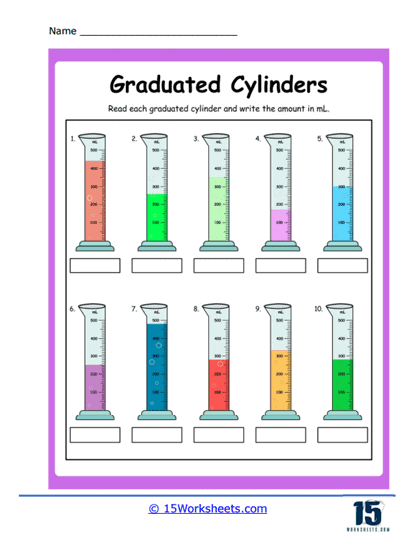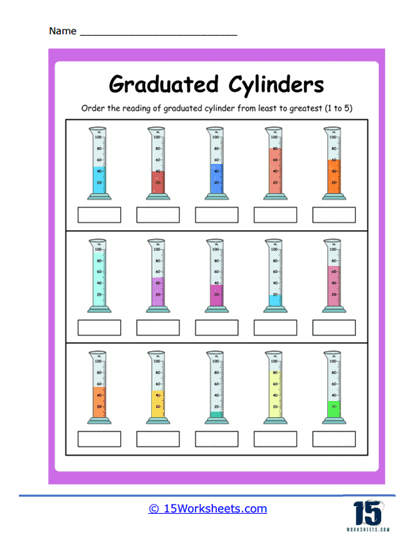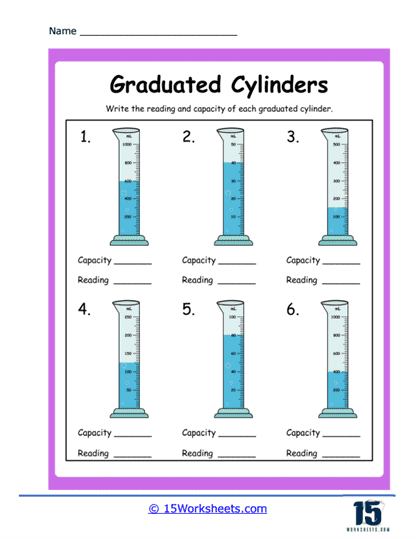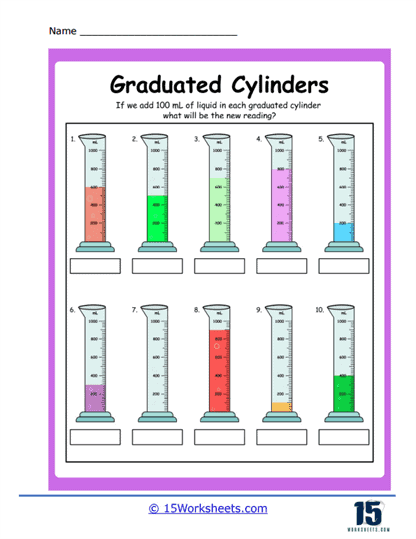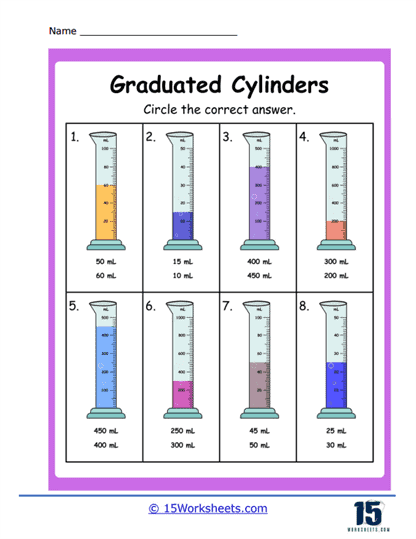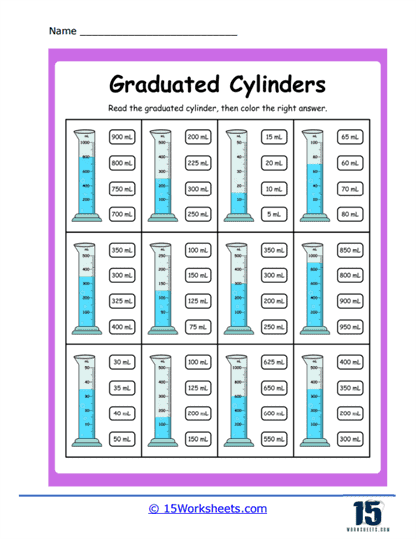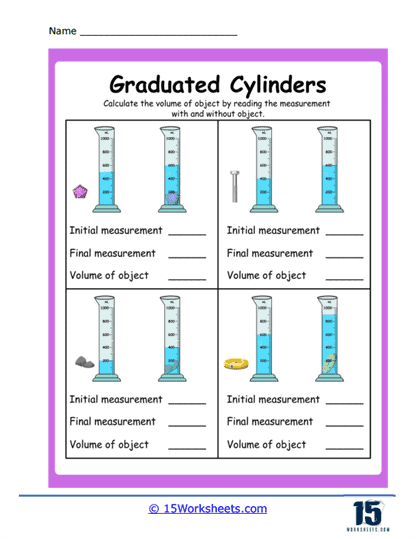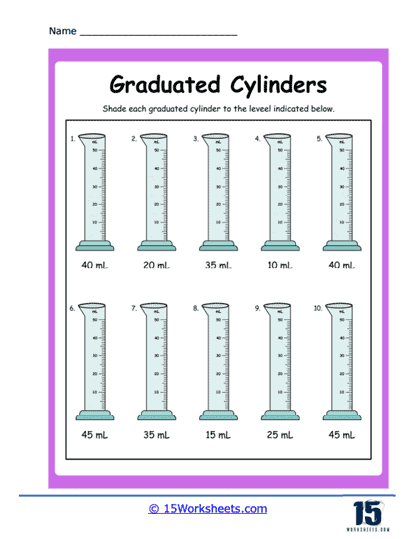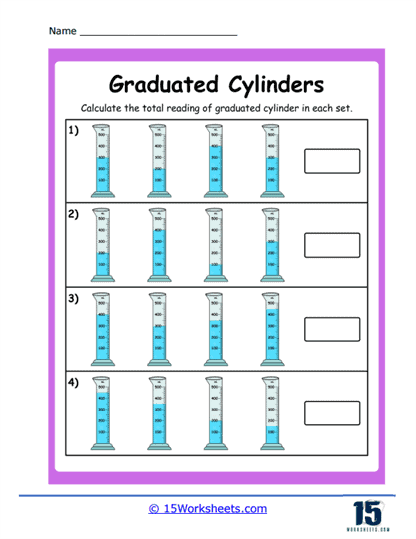Graduated Cylinders Worksheets
About These 15 Worksheets
In the domain of scientific experimentation and measurement, the ability to accurately measure and record the volume of liquids is paramount. Graduated cylinders are one of the most commonly used tools for this purpose. They offer a clear, consistent means to measure liquid volumes with much greater precision than beakers or flasks. This set of worksheets were designed to help students learn how to use this vital science lab tool correctly and understand its importance in various scientific applications.
The focus of these worksheets are on teaching students the correct way to read and interpret the markings on a graduated cylinder. Given that the meniscus (the curve formed by a liquid in response to its container) can cause reading errors, these worksheets help in training students to read from the bottom of the meniscus. The exercises within such worksheets range from basic reading tasks to more complex problems that integrate volume measurement into broader scientific concepts.
Types of Exercises on These Worksheets
Basic Reading Practice – These exercises might provide an image of a graduated cylinder filled with a liquid and ask the student to read and record the volume. This familiarizes students with the cylinder’s gradations and teaches them to read the bottom of the meniscus for accurate measurements.
Comparative Volume Measurement – Students are given images of multiple graduated cylinders with different liquid volumes and are asked to order them from least to greatest or vice versa. This task enhances students’ abilities to compare and contrast volumes, fostering a deeper understanding of measurement.
Determining Measurement Intervals – Some graduated cylinders have different intervals between markings. Students might be asked to determine the value of each interval or line based on given data. This ensures that students don’t make assumptions about measurements and become adept at reading various types of graduated cylinders.
Measurement Error Identification – These exercises might present images where the graduated cylinder is tilted or where the reading is taken from the top of the meniscus. Students must identify the errors in these scenarios. This helps students recognize common mistakes and reinforces the proper techniques for measuring liquid volumes.
Volume Displacement Activities – Students are given scenarios where a solid is placed in a graduated cylinder, causing the liquid’s volume to rise. They might be asked to determine the volume of the solid based on the change. This introduces students to the concept of volume displacement and Archimedes’ principle, linking measurement skills with broader scientific principles.
Mixing Liquids and Observations – Scenarios where two different liquids are combined in a graduated cylinder and students have to predict or identify results, like volume changes or reactions. This task helps students explore the properties of liquids, such as whether they’re miscible, and deepens their understanding of volume and its relevance in scientific experiments.
What Do These Worksheets Teach Students?
Precision in Measurement – One of the fundamental lessons is the importance of precision in scientific measurements. A minor error can significantly impact experimental results, so mastering the art of reading a graduated cylinder correctly is crucial.
Understanding of Liquid Behavior – Through exercises involving the meniscus or volume displacement, students learn more about how liquids behave in containers and when other objects are introduced.
Application of Knowledge – By integrating real-world and experimental scenarios in the exercises, students learn to apply their measurement skills in diverse contexts, seeing the relevance and importance of their learning.
Critical Thinking and Analysis – Worksheets that include error identification or predicting outcomes force students to think critically about what they know and analyze scenarios for accuracy.
Scientific Principles and Theories – Beyond just measurement, these worksheets can introduce and solidify broader scientific principles, like Archimedes’ principle, ensuring students don’t learn in isolation but see the broader context of their knowledge.
This group of worksheets can transform a seemingly simple tool-a cylinder with markings-into a window into the world of precise measurements, liquid behavior, and foundational scientific principles. They ensure that students not only learn the mechanical process of reading a graduated cylinder but also appreciate the importance of accuracy, the behavior of liquids, and the broader applications of volume measurement in science. As students engage with these worksheets, they are equipped with vital skills and knowledge that prepare them for more advanced scientific endeavors.
Reading a Graduated Cylinder Properly
Reading a graduated cylinder properly involves carefully observing the meniscus, which is the curved surface of the liquid inside the cylinder, and taking into account the calibration markings on the cylinder.
Position yourself at eye level with the graduated cylinder. This means your eyes should be at the same level as the liquid surface inside the cylinder.
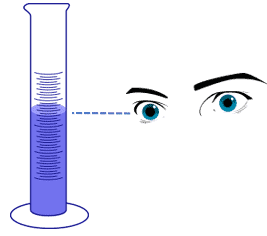
The meniscus is the curved surface of the liquid inside the cylinder. It is often concave, with the center of the curve being lower than the edges. Read the volume at the bottom of the meniscus, not the top or middle. To read the meniscus accurately, look at the point where the liquid level meets the graduated scale.
Graduated cylinders come in various sizes and have different scales. Some may have a single scale (e.g., milliliters), while others may have multiple scales (e.g., milliliters and fluid ounces). Identify the smallest division (e.g., milliliters) on the scale, which represents the precision of the measurement. For example, if the smallest division is 1 ml, you can estimate readings to the nearest 1 ml. Record the volume by noting the number on the scale that corresponds to the bottom of the meniscus.
If the meniscus falls between two markings on the scale, estimate the measurement based on the divisions. For example, if the meniscus is between the 20 ml and 21 ml marks, you can estimate the volume as 20.5 ml.
Always remember to handle the graduated cylinder with care to prevent spills or damage, and double-check your reading to ensure accuracy. If you need a highly precise measurement, use a graduated cylinder with a scale appropriate for your needs and take your time to make an accurate reading.

